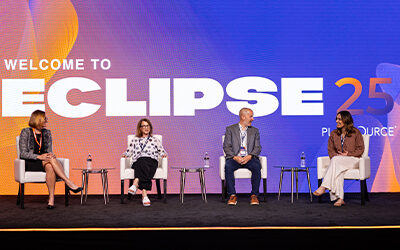10 Open Enrollment Tips To Energize And Engage Employees
Liz Dillon
It’s time to turn that open enrollment frown upside down! Nancy Sansom, Chief Commercial Officer here at PlanSource, has 10 open enrollment tips to help you plan a stress-free and successful enrollment period.
Tip #1: Conduct an active enrollment
With an active enrollment, your employees are required to make decisions about their benefits, rather than have their prior elections simply “roll over” to the new benefits year.
It may seem “easier” to administer a passive open enrollment—where elections roll over from the prior year. BUT, if you do it that way….
- Many of your employees won’t even log in to the system
- They won’t even consider new benefits that you are offering
- They won’t take the time to think about how their needs might have changed in the last 12 months
You’ve probably seen the stats – employees spend less than 20 minutes choosing their benefits each year—even though their physical and financial well-being depends on them making the right decisions for their families.
With an active enrollment, your employees are more likely to be engaged and informed about their benefits.
And, if you’re worried about the burden of reminding your employees to enroll—don’t!
Your benefits technology system should make it easy for you to automatically send reminders to people who have not yet completed their enrollment.
Tip #2: Create a communications plan
You don’t want to start crafting your open enrollment comms the day before—or even the week before—your open enrollment begins! You want to treat your OE communications like a full-scale marketing campaign.
I know what you’re thinking—you’re in HR, not marketing—but don’t worry. We have a suggested communications timeline in our online OE kit that you can take a look at, complete with email suggestions and text messaging templates.
At least a month before your OE, you’ll want to map out a steady cadence of email, video, print and face-to-face comms to make sure everyone gets the message before, during and after open enrollment.
About 2 weeks prior to the start of open enrollment, you’ll want to start generating awareness of the open enrollment and providing some basic educational materials (preferably videos).
During open enrollment, your communications should drive employees to action and cover specifics of your benefits offering.
After your OE, your communications can focus on helping your employees get the most out of their benefits.
Tip #3: Know your audience
It’s important to adapt your communications to meet the needs of your workforce.
Survey Employees
If you haven’t ever asked your employees how they want to be communicated with you might want to do a quick survey or focus group to be sure.
You may be assuming that they still want print materials when they don’t, or that they’re excited to start getting text messages from you and they’re not. It will cost you nothing to issue a quick survey!
Demographics are Important
Unfortunately, a one-size fits all approach to your communications is not going to work. Your workforce is likely pretty diverse.
For example, millennials will be more open to receiving texts from you and less likely to read your emails.
Tailor the Message
But, it goes beyond simple demographics and assumptions about what different generations want.
New employees need more information than tenured employees and some personality types simple want to dig into the details, like your engineers, while others don’t, like your sales team.
So, keep your messages short, but provide options to learn more for those that want all the details.
Tip #4: Use multiple communication channels
Along those lines, it’s a best practice to use multiple communication channels so that you can appeal to the different types of people that work for you and their different learning styles.
Educational Videos
The best way to educate employees about different types of benefits is through short, educational videos. Viewers retain 95% of a message when they watch it on video compared to only 10% when reading it in written text (via Wordstream).
To get started, check out our library of educational videos. All the videos are available in both English and Spanish, and you can download these free videos and use them anywhere you want.
Call Center
Depending on your workforce, you might want to allow employees to enroll over the phone with the help of a licensed representative. We see this now mostly with late-career populations.
Print Materials
In today’s environment, we are bombarded with emails, notifications and messages in both our personal and professional lives. Print materials – when used to supplement digital materials and when kept brief and well designed – can be even more effective now than ever before because they really stand out. For example, a postcard that arrives at an employee’s home is likely to get noticed and has the added benefit of reaching the employee’s spouse who may be the true decision maker in the family.
Text Messages
Consider adding text messages to your OE communications. Text messages have a 98% open rate, and 90% are read within 3 minutes. Text messages are great for reminders and notifications. If your benefits technology is mobile-friendly, you can include a link in the text message so it’s convenient for employees to click right on the link to enroll.
You do have to be succinct in your messages obviously, since there is a 160-character limit (this is fine, really – nobody wants to read long messages!), and you do need to have employees opt-in to receive texts from you.
Another great benefit of text messaging is that you can allow spouses to opt-in and keep them in the loop! It’s a best practice to engage with spouses during open enrollment.
Live Meetings
Some people learn best when they have the opportunity to listen and then ask questions. You may want to continue to offer live meetings or, if your workforce is geographically dispersed or includes remote workers, record a video that goes over the details of your new plans. If you do that, the benefit is that you’ll be sure everyone is hearing a consistent message.
Voicemail
Here’s a neat idea—let’s say you don’t have time to record a video with a message from your CEO or head of HR, which is always nice, but that takes a bit of time. A faster, free option is to have an executive record a voicemail that can be sent to all employees—encouraging them to take time to review their benefit options during open enrollment.
For your next open enrollment, I challenge you to incorporate at least 2 new ideas into your OE communications plan.
Tip #5: Use a theme (have some fun!)
Another best practice is to have a theme that ties all of your communications together.
This way, when an employee sees a poster in the break room, it has a similar look and feel as the presentation they saw during the live meeting.
This will make it more memorable for your employees – and more fun for everyone.
Tip #6: Apply marketing best practices
You don’t have to be a marketer to incorporate some marketing best practices into your plan.
Keep messages short and sweet
Don’t try to educate your employees in your communications. Instead, include links to educational videos and other resources.
Put yourself in their shoes
Lead with what’s in it for them – get feedback from a select group of employees to ensure you nailed the message.
Make your message scannable
Your emails and benefit guides will be easier to consume if they use short paragraphs, bullet points, simple formatting and great visuals.
Include calls-to-action and deadlines
Make sure you’re being clear, and remember to include a calls-to-action and details on OE deadlines to create a sense of urgency.
Use attention-getting subject lines (with emojis)
It doesn’t matter how good your message is if nobody opens your email. Use an attention-getting subject line that inspires action or piques the curiosity of your employees. Using emojis will also increase your open rate.
Test your emails on mobile
66% of emails are now opened on mobile devices, so check that your email looks great on multiple screen sizes.
7.) Explain the basics, even if you think they know it
According to a recent UnitedHealthcare survey, only 7% of Americans could define the four basic benefits concepts: premium, deductible, coinsurance and out-of-pocket maximum.
Use short, entertaining videos to explain these concepts because even though you’ve explained it before, your employees likely don’t remember. Don’t just assume your employees understand insurance vernacular. Take the time to educate!
Tip #8: Create differentiation among plan choices and name your plans accordingly
Many of the companies we talk to want to increase enrollment in their high-deductible health plans. They want to help their employees become informed healthcare consumers.
But, HDHPs are confusing to employees. You can help by making sure there is a true differentiation between your traditional plan offerings versus your HDHP offering.
To begin, create a noticeable difference in monthly premiums between high-deductible and non-high-deductible plans.
Also, consider making HDHP designs unchanged or improved, while raising copays and lowering the co-insurance percentage for non-HDHPs.
These changes will encourage employees to adopt your high-deductible offering.
Sometimes the idea of pre-tax benefits or tax savings from an HSA feels too abstract to employees. In fact, 40% of HSA-eligible employees didn’t even bother to open their account in 2017. You can make the tax savings more real to employees by using an example. Use simple math to show your employees the power of their pre-tax contributions.
Our customers have increased their employer contributions to HSAs by 22% since 2016, with an average employer contribution of around $1,000.
If you are contributing, make your contribution front and center. Make it clear that employees are leaving money on the table if they don’t enroll in the HSA-eligible plan and health savings account.
Here is a nice example from my friends at Jellyvision……What sounds more convincing?
Finally – think about how you name these plans. The phrase “high-deductible health plan” sounds intimidating and doesn’t emphasize the benefits of enrolling in that type of plan. Consider calling it an HSA-Eligible Plan instead of a high-deductible health plan, and think about how you are naming ALL of your benefit plans. Emphasize an important and positive feature of the plan in the name (again – think like a marketer!).
Tip #9: Provide a mobile-friendly benefits shopping experience
More than 70% of online time in the U.S. is via a mobile device.
Your employees expect a mobile-friendly benefits shopping experience that’s similar to how they shop for anything else online. Why shouldn’t it be convenient and familiar?
Make sure your benefits partner supports a mobile-responsive experience, which means that your employees don’t have to download anything; the experience will simply adjust to any size device.
Tip #10: Don’t start it on a Monday!
Let’s get super practical. Most open enrollments start on a Monday. While it seems logical, Mondays are hard enough! Don’t do this to yourself.
If you start your open enrollment instead on a Thursday or Friday, then you’ve had all week to finalize things and make sure everything looks great. You don’t want to be finding problems on Saturday or Sunday and then having trouble getting the help you need to make it right. Start OE on the right foot with a mid or late-week launch.
Empathy, Innovation & Action: Top Takeaways from HR Leaders Who Spoke at Eclipse
Empathy, Innovation & Action:Top Takeaways from the HR Leaders Who Spoke at...
Charting the Future of PlanSource: Our Vision for What’s Ahead
Discover how PlanSource unveiled game-changing AI innovations at Eclipse 2025, transforming how HR leaders manage benefits and how employees choose them. The future of benefits starts here.
Navigating New Requirements with the Paperwork Burden Reduction Act
Navigating New Requirements with the Paperwork Burden Reduction...




